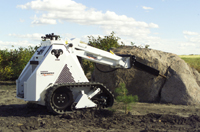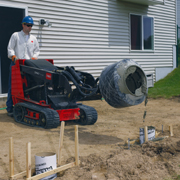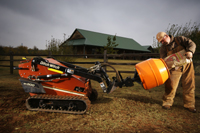The CUL Concrete Crew
 Unique concrete jobs often call for novel approaches — especially
Unique concrete jobs often call for novel approaches — especially
those small-scale worksites in residential backyards or bustling city
side streets where you make and sometimes break up a construction
project.
If you envision every job as a blank canvas, a versatile compact
utility loader is a great multi-tool to tackle every artistic aspect of
those unique concrete applications. These machines can be used for a
wide range of projects, from pouring and building a concrete patio to
demolishing it a few years later. Equipped with the right attachment,
compact utility loaders (CUL) have earned the moniker of a
“do-everything machine” for jobs that require specific and multiple
hydraulic tools for completion.
Don Reed, sales manager for Ramrod, explains the ultimate tool
carrier simply: “The unit is defined by its attachment,” he says. “A
CUL is a power drive unit, so whatever an operator attaches to it
specifies what it does. The attachments make it dedicated to a
particular task.”
The attachments an operator and crew add to a CUL make it an ideal
machine for pint-sized, one-and-run concrete projects. By connecting
concrete specific implements to a CUL (breakers, buckets and cement
bowls for example), a crew can tackle tough jobs that involve all
things concrete. There are concrete breakers or hammers that come
prepared to smash and split tough material into smaller portions ready
to be hauled away. Then come the concrete buckets and cement bowls, the
brew kits and distributors of viscous concrete — ideal for shaking,
mixing and pouring their materials so operators and crews can get small
projects done, in even smaller time frames. All three of these
attachments can be attached to a compact utility loader to turn the
already hard working machine into a master of concrete construction.
Breaking Out
When
the time comes for destruction, a CUL can be paired with a concrete
breaker to rip, destroy and shatter the tough material that stands in
its way. Concrete breakers are attachments that are primarily used for
demolition purposes. For example, CUL breakers are often utilized to
break up concrete in driveways, patios and parking lots. These
heavy-duty attachments allow for areas to be broken apart and carried
away for new construction to take place; attach a grapple bucket to
your CUL and haul off the debris. A concrete breaker is categorized by
its impact energy in ft-lbs. The impact energy class can range from 150
to 300 ft-lbs for compact utility loaders.
“The higher the class of the breaker, the more flow and pressure
will be required from the hydraulic system,” explains Dan Roberts, Toro
Sitework technical service representative. “Concrete breakers are also
measured in blows per minute.”
Like all CUL implements, the breaker is attached to the front end
of a CUL through a universal quick-attach system. For a CUL to operate
a breaker, it must produce 8 to 12 gallons per minute (gpm) of
hydraulic flow for the attachment to work efficiently. When using the
breaker for work on sidewalks, driveways, etc., Jaime Wines, product
manager of compact utility equipment for Ditch Witch, suggests
positioning it vertically and lowering it until it reaches its point of
contact. Then the hydraulics should be activated and the breaker is
ready to operate. Although the breaker attachment is relatively simple
to operate, positioning it when operating may pose some challenges to
the operator.
“The big place you will have difficulties with breaking is when
you’re working pure horizontally,” says Reed. “Horizontal operation is
not recommended with a compact utility loader breaker. An operator can
work in any other position than horizontal. It’s mounted so it can be
adjusted any way. When the breaker is working in pure horizontal
applications, you’re just not maximizing its power.”
A breaker attachment for a compact utility loader can range from
$6,000 to $11,000, depending on manufacturer and any added options.
Different chisel points, moil points and asphalt cutters are
available options to customize a breaker attachment to accommodate
different work conditions. By adding various dedicated chisel or moil
points, an operator can handle specific jobsites with the best possible
break point for the project. Operators should always look to adding
options to customize his or her unit for particular projects.
“It is important to choose the right tool and options for the
material being broken,” says Roberts. “Some manufacturers offer a
tamper tool option in order to compact the soil after demolition, prior
to pouring new material.”
A breaker attachment does require regular maintenance checks to
ensure it is working properly. Today’s breaker attachments require less
maintenance than those prior, especially with keeping its battery
charged.

recharged on a frequent basis,” explains Reed. “Now they can go a year
or two before needing to be recharged.” The moils on the breaker should
also be checked to identify any excessive wear. The material that an
operator is hammering is a big factor in how often the moils will need
to be replaced. Another maintenance concern comes from the CUL itself.
Since the attachment causes a vibration to the machine, parts on the
CUL should be checked to ensure they are fastened on correctly.
“A real challenge lies in that the hammer is vibrating all the
time, so the bushings on the arms of the CUL may need to be replaced or
reinforced,” says Reed. “Regular machines will need to replace the
bushings once or twice a year, while a dedicated machine will have to
reinforce and/or replace them every six months or a year.”
Other maintenance issues and requirements can be found with the
attachment’s operator’s manual, says Wines. The manual should be
consulted for necessary maintenance checks throughout the year.
Bowls of Cement
Another
attachment that turns a CUL into a concrete construction machine is a
cement bowl. Together, the loader and attachment work in harmony to
complete small-sized concrete projects. Cement bowls are used to mix
materials on jobsites where bringing in a large concrete truck is not
possible, allowing crews to get their cement projects completed without
losing productivity. Roberts explains that cement bowl attachments for
CULs are attached to an auger power head, which rotates the bowl. These
attachments usually have paddles and/or flighting inside them to mix
the cement as the bowl rotates.
Cement bowls are generally measured by their volume (in cubic feet)
or the weight of the cement they can mix (in pounds). A cement bowl
often can hold and mix more material than the machine can carry, so
capacity in pounds is a more useful number to compare. The maximum
mixing capacities of cement bowls range from 2.2 to 3.1 cu ft, which
makes them ideal for tackling small jobs where not a lot of cement is
needed.
“A cement bowl would be used for smaller jobs,” says Reed. “A
fencer may use it for cementing post holes. It can be used for
maintenance or small repair jobs. A bucket is good for projects where a
contractor has to travel a bit for jobs — where you use a little bit of
cement somewhere and move on to the next project.”
The compact utility loader’s hydraulic flow rate affects the
rotation speed of the cement bowl. A higher flow rate is suggested for
operating the attachment, so operators have precise control over the
cement bowl and its speed.
“It is good to have higher flow rate for this attachment so
operators can slow the CUL’s engine rpm in order to turn the bowl at
the desired speed,” says Roberts.
In order to use a cement bowl attachment, certain precautions should be
taken during and after operation — considerations that can ensure
productive work on any jobsite. Roberts offers three operational tips
when using a cement bowl attachment: 1) do not exceed the maximum
capacity of the cement bowl; 2) slow down the bowl’s revolutions when
pouring the cement to avoid spills and unnecessary jobsite mess; and 3)
clean the bowl while the cement is still wet to make end-of-day cleanup
quick and easy.
A cement bowl attachment for a CUL costs between $600 and $1,000,
depending on the manufacturer. Just don’t forget the simple
maintenance, which must be performed to the attachment. The bowl should
be cleaned out after every use; Wines recommends for an operator to
refer to the attachment’s operator’s manual for proper maintenance.
When storing the attachment between uses, make sure the bowl is clean
and kept in a position where it will not retain water.
“Keep the cement bowl out of rain and other weather elements,” says
Reed. “The attachment is made of metal and could possibly rust.”
Concrete Mix Up
Like a child shaking two dice in their hands and carefully dropping
them onto a game board, CULs employ the same tactics when using a
concrete bucket. The mixture is ground finely in the bucket and
dispersed precisely onto the jobsite. Concrete buckets are attachments
used to mix and discharge cement or concrete in tight work areas where
cement trucks are not an option or one isn’t needed because it is a
small job.

for fixing a portion of driveway or patio,” says Reed. “Landscapers,
fencers, demolition guys and contractors would find them useful.”
Sizes of concrete buckets vary depending on the size of the CUL and
what necessary jobs it must perform. There are standard buckets and
heavy-duty reinforced buckets available, says Reed. A reinforced bucket
employs heavier-gauge steel, so it can handle larger capacities on the
jobsite. Bucket capacities typically range between 4.7 and 13.5 cu ft.
A concrete bucket mixes the material and prepares it to pour. The
attachment uses a discharge chute to place concrete exactly where it is
needed, which is ideal for an operator to have precise control when
filling a small area with concrete. Concrete jobs can be completed
quickly, as a full bucket can be discharged in 50 seconds. According to
Reed, Ramrod offers a bucket that can be tilted 85 degrees, while most
other units angle around 60 degrees.
A concrete bucket can range in price from $1,500 to $6,000,
depending on the manufacturer and options added to the attachment.
The
available options for concrete buckets include powered and non-powered,
varying sizes and side or front discharge. Side delivery buckets allow
the operator to dump the concrete to the left or right, rather than
forward, says Reed. This option enables the operator to pour the mix
without having to backup the CUL and pull forward. Concrete buckets
have a similar maintenance regimen as cement bowls. In particular, the
bucket should be cleaned immediately after use.
“It’s important to keep the bucket clean after using it,” explains
Reed. “Otherwise the concrete can cake up inside. Just spray it down
and it’s clean and ready to go for the next time.”
Next time a compact utility loader is called upon to complete a
concrete specific job, operators can look to three different
attachments that can define the machine’s purpose and practicality.
Whether it’s destroying already constructed concrete or mixing up a new
batch, there’s an attachment that can help get the job done right.
Pam Stask is assistant editor of Compact Equipment.

Comments are closed here.